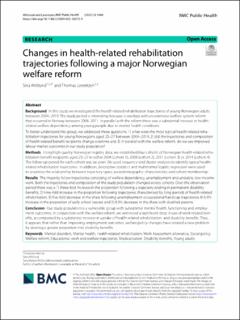| dc.description.abstract | Background
In this study we investigated the health-related rehabilitation trajectories of young Norwegian adults between 2004–2019. The study period is interesting because it overlaps with an extensive welfare system reform that occurred in Norway between 2006–2011. In parallel with the reform there was a substantial increase in health-related welfare dependency among young people due to mental health conditions.
To better understand this group, we addressed three questions: 1) what were the most typical health-related rehabilitation trajectories for young Norwegians aged 23–27 between 2004–2019, 2) did the trajectories and composition of health-related benefit recipients change overtime and 3) in parallel with the welfare reform, do we see improved labour market outcomes in our study population?
Methods
Using high-quality Norwegian registry data, we established four cohorts of Norwegian health-related rehabilitation benefit recipients aged 23–27 in either 2004 (cohort 1), 2008 (cohort 2), 2011 (cohort 3) or 2014 (cohort 4). The follow-up period for each cohort was six years. We used sequence and cluster analyses to identify typical health-related rehabilitation trajectories. In addition, descriptive statistics and multinomial logistic regression were used to scrutinise the relationship between trajectory types, sociodemographic characteristics and cohort membership.
Results
The majority follow trajectories consisting of welfare dependency, unemployment and unstable, low-income work. Both the trajectories and composition of the study population changed across cohorts. Over the observation period there was a 1) three-fold increase in the proportion following a trajectory ending in permanent disability benefits, 2) nine-fold increase in the proportion following trajectories characterised by long periods of health-related rehabilitation, 3) five-fold decrease in the share following unemployment occupational handicap trajectories 4) 6.9% increase in the proportion of early school leavers and 5) 8.9% decrease in the share with disabled parents.
Conclusion
Our study population is a vulnerable group with suboptimal mental health, functioning and employment outcomes. In conjunction with the welfare reform, we witnessed a significant drop in use of work-related benefits, accompanied by a substantial increase in uptake of health-related rehabilitation- and disability benefits. Thus, it appears that rather than improving employment outcomes, welfare policy changes have created a new problem by steering a greater proportion into disability benefits. | en_US |

